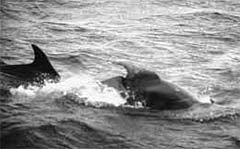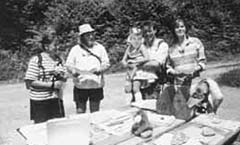|
|
|
|
Meeting the variety of conservation challenges in Cornwall requires a corresponding variety of conservation programmes - as well as close co- operation between volunteers, staff and organisations. Here is a small sample of our work for wildlife in all its diversity. Photographic Group April seems a long time ago. We had various problems receiving the travelling portfolio of the Royal Photographic Society's Nature Group but it was worth the wait. This year's exhibition was the best that I can remember seeing, and looking at other people's work should stimulate us to recreate it ourselves. In May we had a talk on Antarctica by Hazel Meredith. Her slides were of an excellent standard and her knowledge of her subjects was thorough. She gave us a very enjoyable trip through this extreme part of the globe. June saw our very own Howard Miles discussing the eclipse and how to photograph it. His knowledge of this subject is second to none in this part of the country. Not surprising, then, that we had visitors from as far away as Kent! Also in June we had the Photography in the Wild exhibition. I will not talk at length in this article because I am sure there will be other space devoted to it, but I would like to thank Peter King and Sally Hawkins for their work in making it happen. I must also say that I was very impressed by the standard and quantity of photographic work that our county's photographers could muster - thank you to everyone that exhibited. I would like to see more of you at the Photographic Group's meetings! Don't forget that our annual competition is in November - please get your entries to me by 15th October 1999 (see the diary for more details). David Chapman Seal Group In recent months, we have been tracking grey seals wearing hats - some of which have been attached in Brittany, Wales and Cornwall. Your reports have either given us the "registration number" on each hat or have allowed us to identify them using a powerful telescope. Therefore, please keep those sighting reports coming in - every single one yields an important detail of insight.
The Seal Group is about to embark, in collaboration with Cornish fishermen, on an examination of the extent to which seals affect the local fishery - including the identification of "hot spots" - and the extent of the by- catch problem. We would also like to hear of any sightings of killer whales - orcas - in local waters. We are interested to examine any impact on the seal population. Has anyone observed an orca making a kill? Finally, please let us know of any sightings of white- coated seal pups. Stephen Westcott Otters and Rivers Project Cornwall and Devon have the highest population of otters in England. However, it has still come as quite a surprise that so many of you in Cornwall have actually seen otters - and in all sorts of places. I've had reports from river banks (as might be expected), along roads (crossing over them when the rivers have been in spate) and in private gardens (happily fishing from ornamental ponds). In all cases I'm keen to receive these reports and have advised on: road "hot spots"; school and college projects on semi- aquatic mammals; fish farms suffering from otter predation; green tourism projects and suspected mink problems. It has been a tremendous start to this new project and I'm delighted to have met so many enthusiastic and interesting people at a range of events. As with all jobs, there is a down side to the work too and there has been a number of road kills already this year. However, working with the Environment Agency, we have got these otters (in various states of decomposition) to Vic Simpson, the local veterinary pathologist, for an autopsy. Vic's research has provided an invaluable insight into our Cornish otters - and we know that there is a young, healthy population. On another positive note, I have received reports of otters on The Lizard, an area with virtually no records at all. If you would like to know where to look for them and how to identify their signs, come along to an Otter Spotter training session. I am organising a number of these all over Cornwall for groups of up to ten people. Please contact me on (01872) 245514 for further details and do keep telling me about any otter sightings. Kate Stokes RIGS Group Locally, the most obvious growth in our activities is in our web site, carefully tended by Jayne Herbert: www. wildlifetrust. org. uk/ cornwall/ geology. htm. The site now includes a growing collection of images of Cornwall's geology and landscape, a list of field guides and where to buy them, and a geological map of Cornwall (courtesy of the British Geological Survey), as well as many links to help you start exploring the world of geology and geoconservation. The Natural History Museum (dinosaurs and the Earth Galleries), the Geological Society (with pages specially for teachers), French geological reserves, the geology of US National Parks ... start surfing here! Less obvious local growth includes papers on Praa Sands and on abandoned quarries, delivered at conferences and soon to be published, as well as input into the Quaternary Research Group's field meeting in Cornwall, attended by geologists from several countries. Our eighth AGM is on Saturday 13th November in Saltash. Everyone is welcome to the field meeting (10.00am from Saltash School) and the AGM at 2.00pm, kindly hosted by the school and organised by Gordon Neighbour, the RIGS representative in Caradon. With such a venue it should not surprise anyone that the theme this year is "Using geological features in the National Curriculum". Nationally, the 57 RIGS Groups throughout the UK have set up an association based within the Royal Society for Nature Conservation (the parent body of The Wildlife Trusts). The second UK RIGS Conference (and the first national AGM) was in Worcester. The proceedings of the first conference are held at Allet should anyone wish to consult them. John Macadam Mammal Group Hear it. See it. Feel it. Smell it. Taste it. Well no, the Mammal Group didn't go that far at the Mammal Mosey re- launch event at Cabilla Woods in July. It did, however, encourage the use of all other senses when talking to
mammal detectives and showing them a range of mammal signs. Those who employed their sixth sense, when they got the eerie feeling they were being watched, saw two magnificent stags on the bank opposite watching them. It was a day of education, fun and relaxation for all and was supported by the Bat Group, Brock, BTCV, Cornwall Wildlife Trust, Environment Agency, Hedgehog Rescue, National Trust, Pennon, Seaquest South- West, Silvanus Trust and Mammal Society. The Mammal Group is organising a range of events and we particularly need help with small mammal surveying on road verges. Although roads pose a serious threat to many mammals (see Otters and Rivers Project article), road verges can somewhat ironically provide relatively undisturbed habitats. These "green" corridors are an increasingly valuable nature conservation resource. So to help us work out what our road verges harbour and how best to manage these areas, please get in touch. Kate Stokes And there's more ... Our joint marine initiative with the Devon Wildlife Trust, Seaquest SouthWest, has been constantly in the news. The Seaquest basking shark project, directed by Colin Speedie and funded by WWF and The Wildlife Trusts, is yielding vital new information. Your sightings of sea creatures are also essential to our knowledge - please keep looking. The Bat Group and Bat Hospital have been another focus of media attention, particularly from eclipse reporters. To complete this round- up, we must mention two essential aspects of our work which link everything covered so far. The first is ERCCIS, the Environmental Records Centre for Cornwall and the Isles of Scilly, which continues to develop and provide a sound knowledge base for conservation. The second is the Cornwall Biodiversity Initiative, in which the Trust is a partner, which is overseeing the implementation of Cornwall's Biodiversity Action Plans. Look out for further news of these in the next issue. Mark Nicholson |



